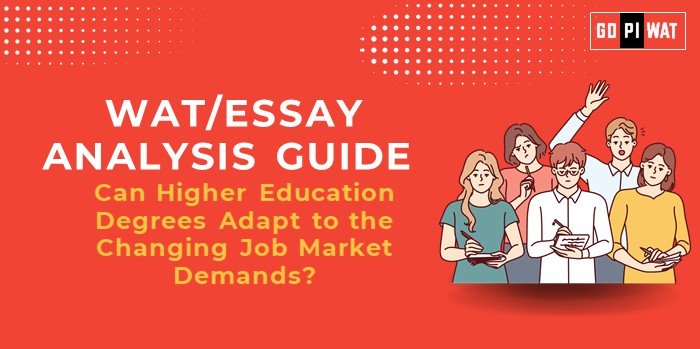📋 WAT/Essay Analysis Guide: Can Higher Education Degrees Adapt to the Changing Job Market Demands?
🌐 Understanding the Importance
Adapting higher education to job market demands is critical for sustaining economic growth, addressing unemployment, and fostering innovation. As industries evolve due to technological advancements and globalization, education systems must keep pace to produce employable graduates equipped with relevant skills.
⏳ Effective Planning and Writing
- 📝 Time Allocation:
- ⏳ Planning: 5 minutes
- ✍️ Writing: 20 minutes
- 🔍 Review: 5 minutes
- 📊 Preparation Tips: Research industry trends, compile statistics, and outline arguments with examples of global best practices.
🖊️ Introduction Techniques for Essays
- 🔀 Contrast Approach: “While automation creates opportunities, 54% of graduates remain unemployable due to outdated curriculums.”
- 💡 Solution-Based: “Adapting higher education to job demands is no longer optional but essential for global competitiveness.”
- 📜 Historical Context: “Degrees once defined job readiness, but the digital revolution demands a paradigm shift.”
🗂️ Structuring the Essay Body
🏆 Achievements
- 📚 Innovations in Learning: The rise of online certifications, micro-credentials, and modular degree programs cater to skill-based learning.
- 🤝 University-Industry Collaborations: Programs like co-ops and internships bridge the skills gap by integrating academic learning with real-world experience.
- 🌍 Government Policies: Initiatives like India’s National Education Policy (NEP) 2020 emphasize vocational training alongside traditional degrees.
⚠️ Challenges with Comparative Analysis
- 📉 Outdated Curriculums: Many universities struggle to align with industry trends, leading to skill mismatches.
- 💰 Economic Disparities: Limited access to technology and modern teaching methods in developing nations worsens employability gaps.
- 🌐 Global Comparisons: Germany’s apprenticeship system successfully integrates skills training, while Finland’s modular curriculums ensure flexibility and adaptability.
🔮 Future Outlook
- ✨ Policy Recommendations: Introduce AI-driven adaptive curriculums and encourage lifelong learning through micro-credentials.
- 🏫 Global Best Practices: Incorporate Germany’s apprenticeship model and Finland’s flexible education framework to bridge the skills gap.
- 🤝 University-Industry Partnerships: Strengthening collaborations with emerging industries to align curriculums with market demands.
🗯️ Concluding Effectively
⚖️ Balanced Perspective
“The transition from traditional degrees to skill-based learning must balance foundational knowledge with industry relevance.”
🌍 Global Comparison
“India can learn from Germany’s apprenticeship model while scaling its online education initiatives to meet global job market demands.”
🔍 Analyzing Successes and Shortcomings
- 🏆 Key Achievements: Adoption of online learning platforms, government policies promoting vocational education, and university-industry partnerships.
- ⚠️ Ongoing Challenges: Skill mismatches, outdated curriculums, and affordability issues for marginalized communities.
- 🌐 Global Context: Finland’s modular curriculums and Germany’s apprenticeship system set benchmarks for adaptive education models.
🚀 Recommendations for Sustainable Progress
- 🧩 Promote Micro-Credentialing: Introduce short-term, targeted skill programs alongside traditional degrees.
- 🤖 Leverage AI and Big Data: Develop adaptive curriculums that evolve with real-time industry trends and market needs.
- 🤝 Strengthen Collaborations: Foster university-industry partnerships to create job-ready graduates equipped with in-demand skills.
✍️ Sample Short Essays (100 Words Each)
⚖️ Balanced Perspective
“Higher education must evolve to address the growing skill gap in today’s workforce. Blending traditional knowledge with vocational training can foster both intellectual growth and industry readiness. Programs like modular curriculums and micro-credentials offer flexibility, ensuring students gain both foundational knowledge and practical skills to succeed in dynamic job markets.”
💡 Solution-Oriented
“Universities must adopt modular curriculums and partner with industries to ensure graduates are employable in emerging fields like AI and data analytics. Policies promoting adaptive learning models, combined with real-world skill acquisition through apprenticeships, can bridge the gap between higher education and job market demands.”
🌍 Global Comparison
“Drawing inspiration from Germany’s apprenticeship system and Finland’s flexible curriculums, higher education in India can balance accessibility with job market alignment. By investing in university-industry collaborations and modern technologies, developing nations can equip graduates with relevant skills for an evolving workforce.”
🎓 Connecting with B-School Applications
- 🌐 Real-World Applications: Explore the integration of adaptive education systems in corporate training and workforce development programs.
- 💬 Sample Interview Questions:
- 💡 “How can universities better align curriculums with the demands of emerging industries?”
- 💡 “What role can modular and skill-based education play in reducing unemployment?”
- 🚀 Insights for Students:
- 📊 Analyze case studies of successful apprenticeship models and adaptive learning systems.
- ✨ Leverage concepts of lifelong learning and micro-credentialing for entrepreneurial and consulting opportunities.


